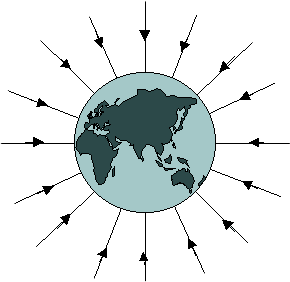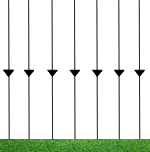Gravitational Field Strength (g)
The gravitational field is radial - the field lines pulling directly towards the centre. The closer in we get, the stronger the pull. This is shown by the field lines being closer together. The concentration of gravitational field lines is an indication of the gravitational field strength at any point, which is formally defined as: The gravitational force per unit mass at that point. So we can write that statement as an equation: Let
Then g = F/mThe unit will be newtons per kilogram (N/kg) From F = ma you know that a = F/m, so gravitational field strength is the same thing as acceleration. In the 'olden days' (when I studied physics - we put the unit of g as that of acceleration and referred to 'g' as acclereation due to gravity...) A gravitational field strength of 9.81 N/kg therefore causes an acceleration of 9.81 m/s2. This is the average gravitational field strength at the surface of the Earth - a distance of the radius of the Earth from the point the field lines come from. A common mistake to make in questions is to forget that the radius of the Earth needs to be included in calculations. Example: A satellite is 4000 km above the Earth's surface. What is the acceleration due to gravity at this point? (Mass of Earth = 6.0 × 1024 kg - Radius of the Earth = 6.37 x 106 m) r = (4.0 + 6.37) x 106m = 10.37 x 106m g = -GM/r2= (6.67 x 10-11 x 6.0 × 1024)/ (10.37 x 106)2 = 3.72 ms-2 Gravitational Field strength is a vector because it has a direction. Parallel lines of the Gravitational Field near the Earth' SurfaceIf we look at a small section of the Earth's surface it appears to be flat. For many years people thought the Earth WAS flat!
This is similar as to how we think of the rays of the sun as being parallel when they reach the Earth's atmosphere. Click here
Click here to find out about gravitational potential |
Follow me...
|


 The Earth, in common with many other planets, is very nearly a perfect sphere Although we think that the bumps on its surface (such as Mount Everest!) should make it a 'bumpy sphere, the size of it makes it a relatively smooth ball - in fact smoother than a billiards ball.
The Earth, in common with many other planets, is very nearly a perfect sphere Although we think that the bumps on its surface (such as Mount Everest!) should make it a 'bumpy sphere, the size of it makes it a relatively smooth ball - in fact smoother than a billiards ball. If we consider the field lines over a section of the Earth's surface we find that they are virtually parallel, rising perpendicular to the surface up into the 'sky'. The field is then a uniform field. It is still the same field but we are just looking at a tiny portion of it.
If we consider the field lines over a section of the Earth's surface we find that they are virtually parallel, rising perpendicular to the surface up into the 'sky'. The field is then a uniform field. It is still the same field but we are just looking at a tiny portion of it.


